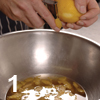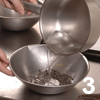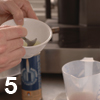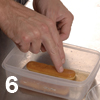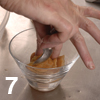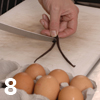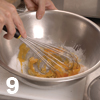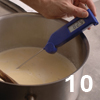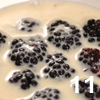Trifle revival
Let's start this masterclass with a bit of culinary history. The first recognisably modern trifle appeared in the fifth (1755) edition of Hannah Glasse's, The Art of Cookery Made Plain and Easy
She opened the door to literally hundreds of variations, and there was a fairly long period after the Second World War and lasting into the 1970s when trifle was an unattractive restaurant cliché. It belonged to the era of the sweet trolley. The waiter glided to the table and scooped out spoonfuls of gloopy cream and custard on to the customer's plate.
Plate service, arriving with nouvelle cuisine, helped to end the public appetite for both trolley and trifle. In a sense it was a blessing. Too often professional kitchens got away with versions that showed neither professional skill nor conscience. It was a cheap, easy option, high in sugar and fat, low on imagination, designed without any thought of what it could be or what it had once been.
The elements that make up a trifle worthy of the name are a sponge, a custard and a cream layer. The sponge should be moist from alcohol but not crumbly. Custard should be rich but not thick like crème pÁ¢tissière. Over these, in Hannah Glasse's day, a syllabub was always piled. A syllabub used to be a sweetened froth of cream and alcohol, a cold precursor of the cappuccino. In one form the wine or cider used would have sunk below a foamy layer of cream. In another, the "everlasting syllabub", the cream stabilised the alcohol. This was the ideal topping for trifle that became debased into the over-whipped cream that could be cut with a knife.
At the Hinds Head in Bray, Berkshire, where Dominic Chapman and Heston Blumenthal are working to revive the best practice in traditional British cooking, their trifle, although served as individual portions, respects the principles that cooks 250 years ago would recognise.
Hinds Head trifle Cost price About 90p
Selling price £4.75
Planning 1. Syllabub base 24 hours ahead
2. Green tea infusion
3. Sherry and tea syrup
4. Trifle base
5. Custard (six-hour rest)
6. Syllabub
7. Finishing
Syllabub base The quantity below makes about 400ml, enough for about 20 individual trifles.
It needs to stand for about a day for the flavours to mature.
Ingredients
Zest of 1 lemon
40g sugar
250ml sweet cider
4tbs brandy
4tbs amontillado sherry
Method
Combine all the ingredients. Cover and refrigerate until needed (1 & 2).
Variations
This recipe is very close to the classic version that has been prepared for over two centuries. It's possible to substitute wine for cider or vary the ratios of the alcohols to achieve different effects.
Alternatively fruit purée, with or without alcohol, can be whisked into the cream. For chocolate, coffee or praliné trifles, these ingredients could also be used.
Trifle base The Hinds Head prepares up to 40 individual trifles at a time. The following proportions represent the minimum quantities that work and can be multiplied as necessary.
Ingredients
(Serves four)
10g green tea
195ml boiling water
15g sugar
75ml amontillado sherry
7ml fresh lime juice
8 sponge fingers
Method
Put the tea in a basin or jug and pour over boiling water (3). Infuse five minutes. Strain 75ml tea into a fresh pan (4).
Dissolve the sugar in it. Add sherry and lime juice (5). Cool. For each individual glass bowl, dip two sponge fingers in the light tea syrup (6). Avoid soaking them or they will crumble, but they should be soft and moist. Line the bowl with two sponge fingers, so they fit the base (7).
Variations
For practical reasons, the Hinds Head buys in its sponge fingers. Trifle sponges would work in small amounts. A combination of sponge and ratafia biscuits is good, but in a different recipe balance. It would dominate the subtle green tea taste. Other flavoured stock syrups could be used instead of the tea. In the earliest recipes, the sponge base was moistened with only sherry and brandy. Ginger wine, at Christmas, with or without whisky, has a Scottish pedigree going back to the 1820s.
Custard
The quantities below make about one litre of custard, enough for 12 trifles. It can be multiplied, but use a large sauté pan if possible and stir throughout. The Hinds Head works with a probe to control the critical temperature (82°C). The traditional "heat the custard until it coats the back of a wooden spoon" method works, but any error is expensive.
Ingredients
1 Tahitian vanilla pod
375ml unskimmed milk
375ml double cream
110g caster sugar
210g egg yolks
Method
Split the vanilla pod and scrape out the seeds (8). Put the pod, seeds, milk and cream in a stainless steel or enamelled pan.
Simmer for five minutes.
Whisk the sugar and yolks together (9). Pour over the vanilla-flavoured milk. Pour into a shallow pan. Heat to 82°C (10), stirring throughout.
When it reaches this temperature, pour into a bowl or basin, set over ice to prevent carry-over cooking. Remove the split vanilla pod.
While the custard is still warm, pour one 65ml ladleful of custard over the sponge fingers. Leave at least six hours to set.
Variations
The advantage of this custard is that it's rich without being heavy. Many old-fashioned trifle custards containing flour or cornflour were claggy.
It is, of course possible to reduce the cream or the egg content and to thicken the custard with a starch, but a solid layer sitting on top of the sponge tends to be coarse and uninteresting.
Fruit
The Hinds Head uses seasonal fruit, typically berries, with optimum flavour rather than fruit preserves such as raspberry jam which were once a popular trifle ingredient. In winter, it replaces the fresh fruit with a thin layer of redcurrant jelly (from a jar, not a packet). For this recipe, allow nine blackberries per portion.
Variations
Raspberries, loganberries, blackberries (11), blueberries and wild bilberries all work well. Strawberries alone can be disappointing because the other flavours in the trifle can dominate them. Combinations of fruit or fruit and fruit preserves can be successful. Exotic fruit need the exotic location's context to make them convincing.
Finishing the syllabub
What makes the Hinds Head trifle different from traditional ones is that the final preparation (making the light "everlasting" syllabub) is done to order. It's difficult to prepare this for less than two servings, so the following quantities are enough for two portions.
Ingredients
30ml syllabub base
60ml double cream
1-2tbs extra amontillado
Method
Whip the cream and syllabub base until it starts to thicken. Add a generous splash of amontillado and continue whipping. Don't whisk until the cream becomes firm - it should be closer to a pouring rather than a spreading consistency.
Assembly and presentation
Ingredients
(Serves one)
1 chilled trifle base
Syllabub
2 crushed amaretti
Method
Spoon enough of the syllabub over the trifle base (sponge fingers and custard) to cover them (12). It should sit on the top so that the layers of sponge, fruit, custard and syllabub are distinctive. Sprinkle crushed amaretti over the top and serve (13).
Variations
The amaretti, or ratafia biscuits, that the Hinds Head uses belong to the trifle tradition. Glacé cherries and angelica don't, and should be avoided. Fruit jellies (pÁ¢tes de fruits) were also a common decoration in Georgian times. Swirls of piped cream have had their day. Flaked, toasted almonds are simple and effective. The point of any presentation is that it should taste good, give extra texture and contribute to the overall enjoyment of the dish.
Dominic Chapman
Dominic Chapman at Heston Blumenthal's Hinds Head in Bray has the ideal job. His boss is as interested in the history of the food as in the science-based cookery.
His father, Kit Chapman at the Castle in Taunton, Devon, deserves credit for coining and promting the concept of modern British cookery that has motivated so many chefs.
Dominic came to Bray after five years working alongside Rowley Leigh at Kensington Place, and aims to create the same atmosphere of "intellegent people working together" in his kitchen. The pub, which serves about 70 customers on weekdays and up to 250 at weekends, isn't competing with the Fat Duck.
Chapman wants it to be viewed as offering reasonably priced unpretentious meals - "food people will understand and food people will want to eat", he says.
Further reading
Trifle (Prospect Books, £8.99) by the late Alan Davidson and Helen Saberi is a book that chefs interested in all kinds of trifle - from zuppa inglese to whim-whams - should buy. It pretty well goes round the world and back again. It's strong on history and packed with original recipes.



